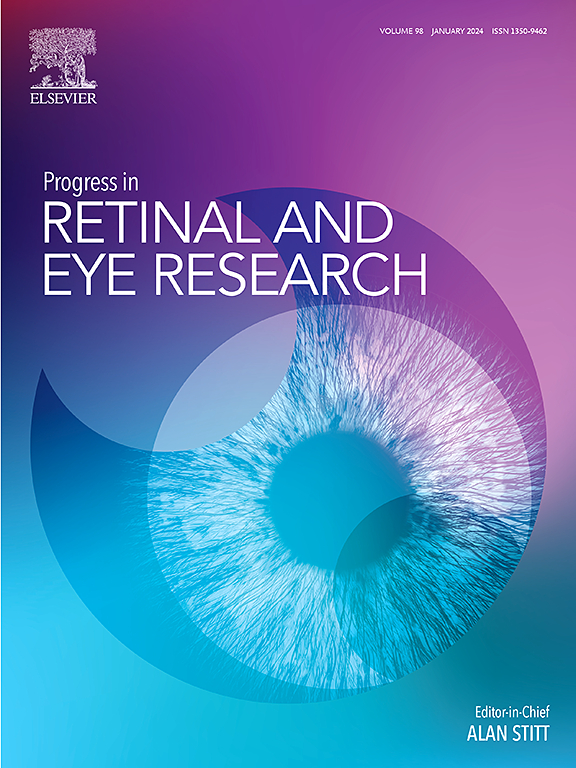AI in the clinical management of GA: A novel therapeutic universe requires novel tools
IF 14.7
1区 医学
Q1 OPHTHALMOLOGY
引用次数: 0
Abstract
Regulatory approval of the first two therapeutic substances for the management of geographic atrophy (GA) secondary to age-related macular degeneration (AMD) is a major breakthrough following failure of numerous previous trials. However, in the absence of therapeutic standards, diagnostic tools are a key challenge as functional parameters in GA are hard to provide. The majority of anatomical biomarkers are subclinical, necessitating advanced and sensitive image analyses. In contrast to fundus autofluorescence (FAF), optical coherence tomography (OCT) provides high-resolution visualization of neurosensory layers, including photoreceptors, and other features that are beyond the scope of human expert assessment. Artificial intelligence (AI)-based methodology strongly enhances identification and quantification of clinically relevant GA-related sub-phenotypes. Introduction of OCT-based biomarker analysis provides novel insight into the pathomechanisms of disease progression and therapeutic, moving beyond the limitations of conventional descriptive assessment. Accordingly, the Food and Drug Administration (FDA) has provided a paradigm-shift in recognizing ellipsoid zone (EZ) attenuation as a primary outcome measure in GA clinical trials. In this review, the transition from previous to future GA classification and management is described. With the advent of AI tools, diagnostic and therapeutic concepts have changed substantially in monitoring and screening of GA disease. Novel technology combined with pathophysiological knowledge and understanding of the therapeutic response to GA treatments, is currently opening the path for an automated, efficient and individualized patient care with great potential to improve access to timely treatment and reduce health disparities.
人工智能在 GA 临床管理中的应用:新的治疗领域需要新的工具。
首批两种治疗老年性黄斑变性(AMD)继发性地理萎缩(GA)的药物获得了监管部门的批准,这是继之前多项试验失败后的又一重大突破。然而,在缺乏治疗标准的情况下,诊断工具是一项关键挑战,因为很难提供 GA 的功能参数。大多数解剖生物标志物都是亚临床的,需要先进而灵敏的图像分析。与眼底自动荧光(FAF)相比,光学相干断层扫描(OCT)可提供神经感觉层(包括光感受器)的高分辨率可视化,以及超出人类专家评估范围的其他特征。基于人工智能(AI)的方法大大提高了临床相关 GA 亚表型的识别和量化能力。基于 OCT 的生物标记分析为疾病进展和治疗的病理机制提供了新的见解,超越了传统描述性评估的局限性。因此,美国食品和药物管理局(FDA)将椭球带(EZ)衰减作为GA临床试验的主要结果测量指标,实现了范式的转变。在这篇综述中,描述了从以前到未来的 GA 分类和管理的转变。随着人工智能工具的出现,在监测和筛查 GA 疾病方面,诊断和治疗理念发生了重大变化。新技术与病理生理学知识和对 GA 治疗反应的理解相结合,目前正在为自动化、高效和个性化的患者护理开辟道路,在提高及时治疗的可及性和减少健康差异方面具有巨大潜力。
本文章由计算机程序翻译,如有差异,请以英文原文为准。
求助全文
约1分钟内获得全文
求助全文
来源期刊
CiteScore
34.10
自引率
5.10%
发文量
78
期刊介绍:
Progress in Retinal and Eye Research is a Reviews-only journal. By invitation, leading experts write on basic and clinical aspects of the eye in a style appealing to molecular biologists, neuroscientists and physiologists, as well as to vision researchers and ophthalmologists.
The journal covers all aspects of eye research, including topics pertaining to the retina and pigment epithelial layer, cornea, tears, lacrimal glands, aqueous humour, iris, ciliary body, trabeculum, lens, vitreous humour and diseases such as dry-eye, inflammation, keratoconus, corneal dystrophy, glaucoma and cataract.

 求助内容:
求助内容: 应助结果提醒方式:
应助结果提醒方式:


